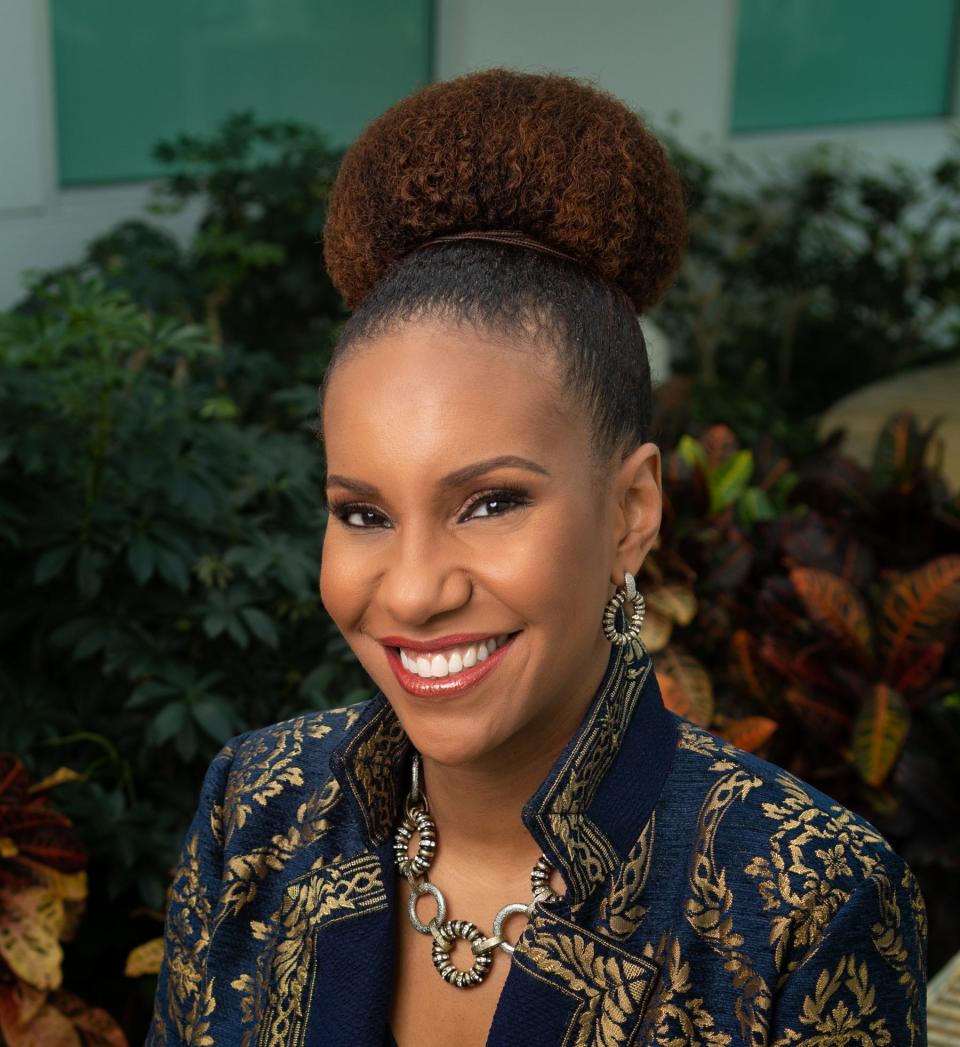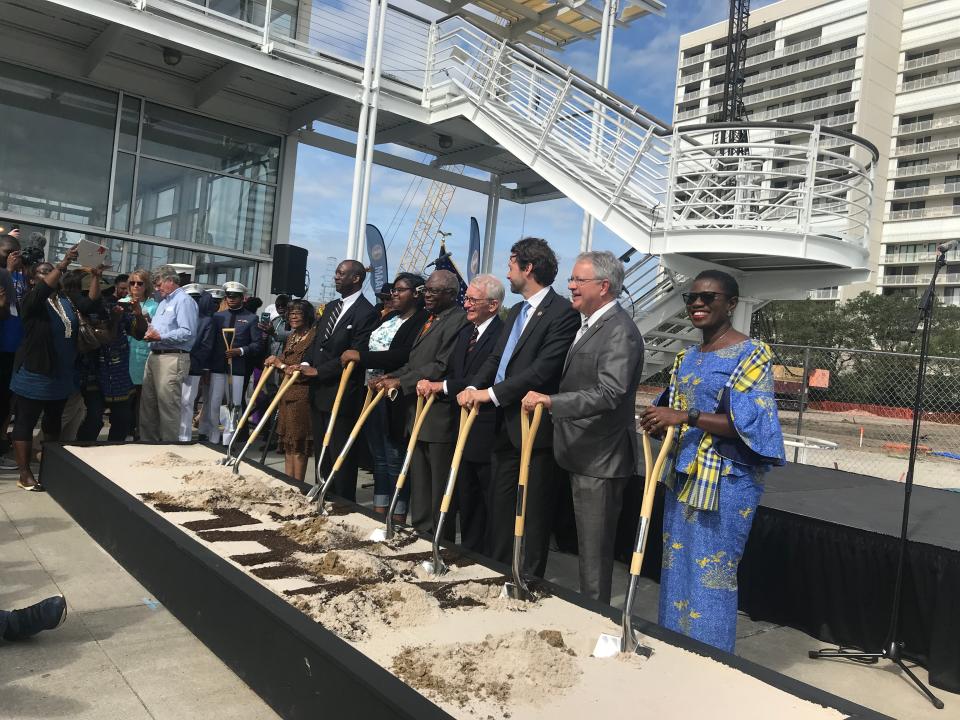Charleston wharf where 100,000 enslaved Africans were imprisoned to become a museum
Centuries ago, an estimated 100,000 enslaved Africans were taken to America by way of Gadsden’s Wharf in Charleston, South Carolina. Enslaved people were shackled and corralled like cattle, hustled off ships and into the wharf’s storehouses before they were sold.
Ten years ago, archeologists discovered the wooden remnants of the 18th-century wharf in the city's downtown area, within miles of its most popular tourist sites.
By the end of this year, overlooking the same water on a site now considered sacred will be the long-awaited International African American Museum with a center for genealogy and a memorial garden leading up to the water’s edge.
“There is something about the energy of the space. There is something about learning about history at the site it happened ... while you're smelling the water coming off of the ocean, while you're feeling the breeze," said Tonya M. Matthews, CEO and president of the museum. "All of that really has a way of centering the story.”
After raising $96 million for its capital campaign from more than 1,000 donors, the museum broke ground in 2019 and began installing exhibitions early this year before its planned opening later in 2022.
The IAAM seeks to tell the “untold stories of the African American journey at one of our nation's most sacred sites,” Matthews said.
Many of these stories have long been silenced, hidden or ignored, she added, and she envisions it as a place of memorial, pilgrimage and celebration.
But with a history that spans thousands of years, what parts will be told? And how?
“This is one of the great challenges of telling the story of the African American journey, that the story is so large, so long, so complex,” Matthews said.
This is their fight, in their words: Americans stood up to racism in 1961 and changed history
'Solidarity is the answer': Amid a rise in hate crimes, Black and Asian Americans are standing together
Slavery in the middle of the story
Topics the museum will cover include the African diaspora, African American cultures and influence, racial justice movements, and family history and genealogy.
The museum will acknowledge the horrors of slavery and its lasting scars, but Matthews said it will also explore what came before slavery, fulfilling the “international” claim in the museum’s name by reflecting the communities and cultures enslaved Africans were taken from. Exhibitions will also examine what came after slavery, recognizing how the United States’ past and present is “built on the labor and genius of enslaved Africans and African Americans,” Matthews said.
“The story of African Americans and Black people all over the globe did not begin or end with slavery,” she said. “Slavery is a critical story, but it is in the middle of this journey.”
'It's like walking a tightrope': Critical race theory bans are adding more anxiety to stressed teachers
US history is complex: Scholars say this is the right way to teach about slavery, racism.
As the main entryway to North America for the transatlantic slave trade, Charleston is also central to stories about the African American journey.
“If any community needs to be at the epicenter of what could be the great unraveling of what we have been taught about this particular portion of the African American journey, it must be about South Carolina,” she added. “It must be Charleston.”

While this region can provide vital lessons on the horrors and politics of slavery, she said it can also teach great things about the resilience and ingenuity of African and African American people, including the Gullah Geechee community, descendants of enslaved Africans with deep roots in the Carolinas.
Matthews said the Gullah Geechee managed to preserve their culture in “rich and robust ways.”
“You can hear it in the way we talk,” she said. “You can smell it in the food. You can see it in the arts and dancing.”
Part of the museum will also be the Center for Family History with a research assistant, genealogists, workstations and access to genealogy databases to help visitors uncover the stories of their own ancestors.

The center also aims to codify nontraditional documents like old family bibles or oral histories because traditional documents may not include enslaved people who were forcibly severed from their communities. As a result, Matthews said genealogy for African Americans is a form of reclaiming identity that was suppressed, hidden or denied.
“Everyone finds grounding in understanding their family and their family story. But for African Americans, it's obviously a much more difficult journey,” Matthews said. “It means that there are long stretches where we are (not) called by name, and so it makes it very difficult to follow the documentation beyond a certain point.”
What about kids of color?: History curriculum, books were written by and for white people
A memorial garden on the museum’s grounds will include an infinity reflection pool with underwater images depicting how people were stored in the bottoms of slave ships. An ethnobotanical garden will celebrate the plants of the Lowcountry region and the seeds that enslaved Africans brought across the water from their homelands.
Speakers will be hidden along the winding paths of the garden, playing conversations in various African languages. The museum hopes to also use the soundscape for music and storytelling, including in the Gullah language.
Matthews’ favorite part of the garden is two granite slabs flanking the sides of the wharf that outline the storehouse. Between them will be kneeling sculptures honoring the people who were enslaved there. Etched in the granite will be Maya Angelou’s famous quote, “Still, I rise.”
When visitors leave, Matthews hopes they see the value of having difficult conversations around race, connect history to their present and future, and are empowered to use their new knowledge to push for justice in their communities.
For Matthews, furthering this mission is a representation of her ancestors’ dreams realized because, in addition to being president of the museum, she is also a descendant of the people the museum centers, honors and celebrates.
“There's such a weighty, beautiful, joyful responsibility in that,” she said. “There are days when it's overwhelming but mostly it is empowering and lifting. ... And I say that from a very personal perspective as I stand on the edge of the wharf and watch the cargo ships go by.”
Contact News Now Reporter Christine Fernando at cfernando@usatoday.com or follow her on Twitter at @christinetfern.
This is America: USA TODAY launches This Is America, a newsletter on race and identity
'Mothers of Gynecology': Monument honors enslaved Black women who were tortured to help advance science
This article originally appeared on USA TODAY: Charleston wharf to become International African American Museum

